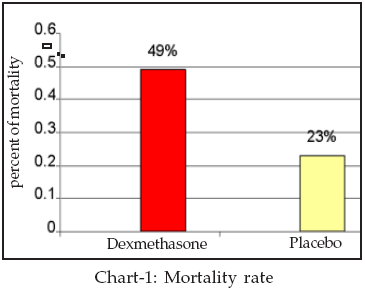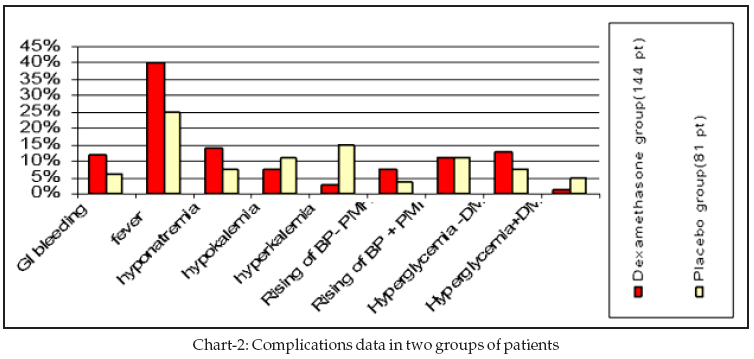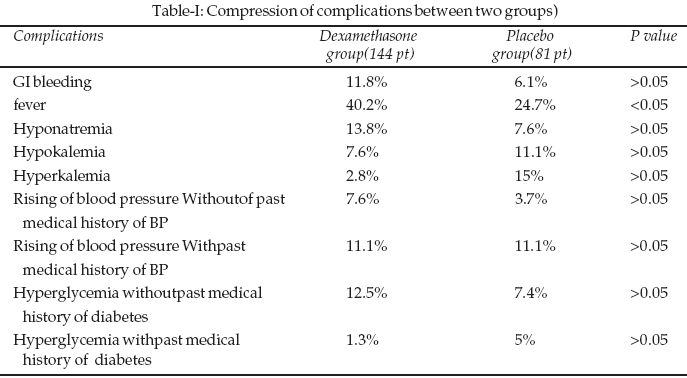|
|
||||
|
Published by : PROFESSIONAL MEDICAL PUBLICATIONS |
||||
|
ISSN 1681-715X |
||||
|
||||
|
- |
||||
|
ORIGINAL ARTICLE- |
||||
|
- |
||||
|
Volume 24 |
July - September 2008 |
Number 4 |
||
|
|
||||
|
|
||||
|
|
||||
|
Published by : PROFESSIONAL MEDICAL PUBLICATIONS |
||||
|
ISSN 1681-715X |
||||
|
||||
|
- |
||||
|
ORIGINAL ARTICLE- |
||||
|
- |
||||
|
Volume 24 |
July - September 2008 |
Number 4 |
||
|
|
||||
|
|
||||
Effects of dexamethasone in primary intracerebral
hemorrhage in the South West of Iran
Sharafadinzadeh N1, Baghebanian SM2,
Pipelzadeh M 3,
Moravej Ale Ali A4, Ghanavati P5
ABSTRACT
Objective: Previous study revealed the value of dexamethasone in the treatment of vasogenic edema associated with brain tumor and abscess. However there are poor documented studies about its usefulness in primary intracerebral hemorrhage. In this study we evaluated dexamethasone effects in primary intracerebral hemorrhage.
Methodology: In a double blind randomized placebo-controlled clinical trial we evaluated 200 intracerebral hemorrhage cases between 40 to 80 years old whom were admitted at Golestan Hospital (Ahwaz, IR) between March 2002 And March 2003. They were divided in two groups; dexamethasone (N=100) and placebo (N=100). Then mortality, GI bleeding, fever, electrolytes disturbances, hypertension and hyperglycemic status were analyzed in two groups. Ethical considerations were employed and subjects were followed by appropriate statistical methods for 21 days to assess the major outcomes.
Results: Mortality was much higher in the dexamethasone group; Dexamethasone group (49.3%) and placebo (23.4%) and also fever was higher seen in the dexamethasone group; dexamethasone group (40.2%) and placebo group (24.7%) but there was not any significant statistical difference between two groups as regards other complications.
Conclusion: Dexamethasone is widely used for cerebral edema associated conditions but in this study we saw that it’s complications in intracerebral hemorrhage such as increasing fever and mortality are significantly higher. Hence it use for treatment of primary intracerebral hemorrhage should be reconsidered.
KEYWORD: Primary intracerebral hemorrhage, Dexamethasone, Complication.
Pak J Med Sci July - September 2008 Vol. 24 No. 4 502-505
How to cite this article:
Sharafadinzadeh N, Baghebanian SM, Pipelzadeh M, Moravej-Ale A, Ghanavati P. Effects of dexamethasone in primary intracerebral hemorrhage in the South West of Iran. Pak J Med Sci 2008;24(4):502-5.
1. Naser Sharafadinzadeh, MD,
Assistant Professor of Neurology,
2. Seyed Mohammad Baghebanian, MD,
Resident of Neurology
3. Mohamad Pipelzadeh, MD,
General Physician
4. Armaghan Moravej Ale Ali, MD,
General Physician
5. Parvin Ghanavati, MS,
Nurse
Clinical Research Center,
1-5: Golestan Hospital,
Ahwaz Jundishapour University of Medical Sciences,
Ahwaz – Iran.
Correspondence
Dr. Naser Sharafadinzadeh
Assistant Professor of Neurology
Neurology Department
Jundishapour University of Medical Sciences
Ahwaz, Iran.
. Email:
sharafaddinzadeh@yahoo.com
* Received for Publication: October 20, 2007
* Accepted: June 8, 2008
INTRODUCTION
Glucocorticoids dramatically and rapidly (in hours) begin to reduce the focal and general signs of brain edema around Tumors. It may be due to direct normalizing effect on endothelial cell function and permeability that is useful for vasogenic brain edema. Brain edema is classified into three major categories; vasogenic, cellular, and interstitial. In vasogenic and cellular edema attention has focused on the role of free radicals (i.e., super oxide, hydroxyl radicals, singlet oxygen, and nitric oxide) and on the effects of polyunsaturated fatty acids especially Arachidonic acid on cell membranes. However, steroids have not been shown to be therapeutically useful in hypoxia or ischemia in brain with edema and cellular damage is more important than brain edema in these conditions.
1 Early enthusiastic report of benefits obtained with cortisone therapy for "apoplectic stroke" and dexamethasone for acute stroke led to usage of corticosteroids for treating or prevention of acute cerebral edema accompanying stroke.2,3 Later, however randomized clinical trial found no benefit from corticosteroids in the treatment of cerebral infarction.2,4 However, there is a similar controversy over the benefit of corticosteroids in treating primary supratentorial intracerebral hemorrhage that remains unresolved. Theoretically, the short term usage of dexamethasone is justified because it lessens the damaging effect of cerebral edema by decreasing intracranial pressure and strengthening the blood-brain barrier as well as counteracting the "stress" situation associated with cerebral hemorrhage. Two studies in year 1973 and 1983 on patients with intra cerebral hemorrhage didn’t show beneficial effects of dexamethasone. In our study we evaluated treatment responses of dexamethasone in cases with intracerebral hemorrhage.METHODOLOGY
In a double blind randomized placebo- controlled clinical trial we evaluated 200 intracerebral hemorrhage cases between 40 to 80 years old who were admitted at Golestan Hospital (Ahwaz, IR) between March 2002 and March 2003. They were divided in two groups; dexamethasone (N=100) and placebo (N=100). Their diagnosis was confirmed by computerized axial tomography. Secondary intracerebral hemorrhage cases were excluded .
Exclusion criteria: A documented arteriovenous malformation, a bleeding disorder, ingestion of anticoagulant drugs, history of peptic ulcer, clinically apparent infection or a neoplasm. Mortality, GI bleeding, fever, electrolytes disturbances, hypertension and hyperglycemic status were analyzed in two groups. Cases were followed up for 21 days to assess the major outcomes. Patients received intravenous injections of either dexamethasone or placebo (saline) for Ten days. A period of ten days was chosen because to it is the time during which cerebral edema most likely occurred; the peak duration being three to five days after acute event. In the dexamethasone group they received 10mg dexamethasone initially, followed by 5mg every six hours for six days, then 5 mg every 12 hours for two days and 5mg for last two days. In the placebo group, injections of saline were given from ampoules filled with colorless solution indistinguishable from dexamethasone. GI bleeding was checked by nasogasteric tube and rectal examination. Patients who died before 48 hours were excluded from the study. SPSS 11 software and chi-square test ant T test was used for data analyzing.
RESULTS

Mortality was much higher in the dexamethasone group; Dexamethasone group (49.3%) and placebo (23.4%) so there was a significant difference between them. (P<0.05) (Chart-1) and also fever was higher seen in the dexamethasone group; dexamethasone group (40.2%) and placebo group (24.7%) so there was a significant difference between two groups (P<0.05) but there was no significant statistical difference between two groups as regards other complications. (Chart-2 & Table-I)


DISCUSSION
Dexamethasone is widely used for cerebral edema associated conditions. Very few applications have been supported by the results of controlled clinical trials.
5 Several studies have denied the benefit of dexamethasone for severe head injury.6 Dexamethasone is useful for edema surrounding tumors, in which a clinical response is definite although it is temporary. In the other conditions such as the vasogenic and cytotoxic edema of cerebral infarction, no benefit has been demonstrated. Even if cerebral edema were important, it seems unlikely that this condition would be improved by dexamethasone, which seems to act against vasogenic cerebral edema rather than the mixed vasogenic and cytotoxic (hypoxic) pattern that is more seen in intracerebral hemorrhage. An increased incidence of gastrointestinal bleeding, infection and exacerbation of diabetic mellitus has been suggested in previous studies of corticosteroid treatment in patients with stroke and neurosurgical conditions.7-9 The selected regimen of dexamethasone that was used in this study was because it is currently used for reducing peritumoral edema and it seems reasonable in view of what was known of the pharmacologic features of dexamethasone. But we were unable to confirm any beneficial results with the use of dexamethasone in the treatment of primary intracerebral hemorrhage. Fever in patients with primary intracerebral hemorrhage has many causes: A-Infectious Causes (1- Aspiration Pneumonia, 2- UTI, 3- Phlebitis, 4- Sinusitis, 5-Parotidities and 6-Oral&dental problems…) B-Dehydration C-Central fever D-Resolve intracranial hematoma. Our results show dexamethasone can increase risk of infections and fever significantly. We therefore conclude that dexamethasone offers no beneficial effects while it also increases the hazard of infection and mortality.REFERENCES
1. Rowland LP. Merritt’s neurology 10th ed. 2000;286-7.
2. Russek Hi, Russeek As, Zohman Bl. Cortisone in immediate therapy of apoplectic stroke. JAMA 1955;159:102-5.
3. Norris JW, Hachinski VC. High dose steroid treatment in cerebral infarction. BMJ 1986;292:21-3.
4. Mulley G, Wilcox RG. Mitchell JRA. Dexamethasone in acute stroke. BMJ 1978;2:994-6.
5. Nelson SR, Dick AR. Steroids in the treatment of brain edema. In: Azarnoff Dl, ed. Steroid therapy. philadelphia: W.B. 1975;313-24.
6. Gudeman SK, Miller JD, Becker DP. Failure of high – dose steroid therapy to influence intracranial pressure in patients with severe head injury. J Neurosurgery 1979;51:301-6.
7. Gebel JM, Broderick JP. Intracerebral Hemorrhage. Neurologic clinic 2000;18(2):419-38.
8. Bradley WJ, Daroff RB, Fenichel GM. Neurology in clinical practice 3rd ed. 2000;1551.
9. Norris JW. Steroid therapy in acute cerebral infarction. Arch Neurol 1976;33:69-71.
HOME | SEARCH | CURRENT ISSUE | PAST ISSUES
Professional
Medical Publications
Room No. 522, 5th Floor, Panorama Centre
Building No. 2, P.O. Box 8766, Saddar, Karachi - Pakistan.
Phones : 5688791, 5689285 Fax : 5689860
pjms@pjms.com.pk